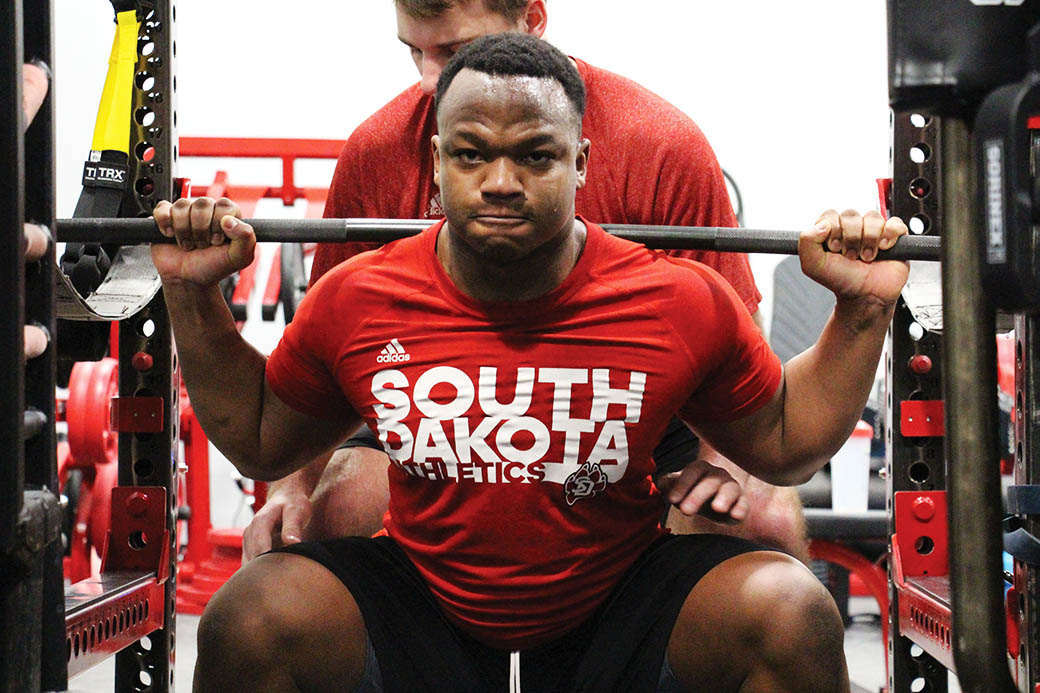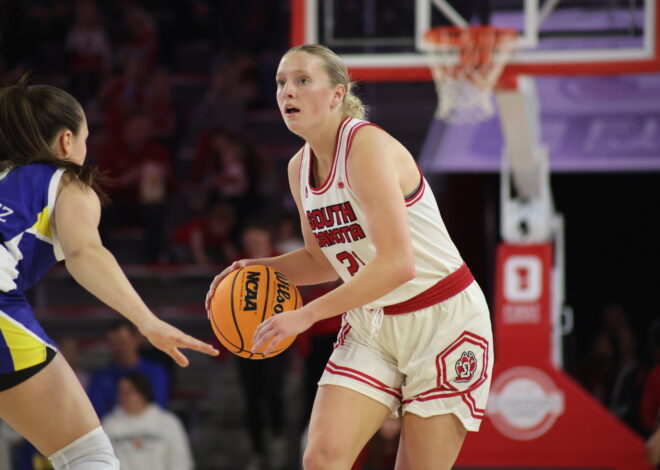
Fall sports focus on strength, improvement during offseason training
Students and fans cheer on USD athletes in their prime: racing on the track, nailing three-pointers or scoring a touchdown. Competition primarily makes up an athlete’s in-season, with some sports having up to three games in a single week.
Competition season, regulated by the NCAA, allows up to 20 hours of practice a week.
Even when competitions are over, practices continue all year for athletes, and offseason training can extend longer than in-season, depending on the sport.
Currently, athletes in a fall sport are in the midst of their offseason training. Athletes are only allowed eight hours of offseason training per NCAA rules.
Jevon Bowman, head strength and conditioning coach, has been working with USD athletes for the past eight seasons, and said the offseason is an important tool in training the
football team.
“Our number one goal is to bring them back, get them moving to our standard, regain the size and strength that we lost through season and turn all that stuff into power,” Bowman said. “We really work technique at the beginning and enforce the little things and progress that through the year.”
For the football team, in-season training differs quite a bit from offseason. While in-season requires careful planning around competition days, Bowman said offseason is the time to “get
after it.”
The team lifts five days a week, completes a running workout twice a week and holds a team competition once a week.
“… We’re working on different skill sets, seeing some leadership, cooperation, cohesiveness and creative thinking on how to accomplish certain goals,” Bowman said. “The offseason is important for building team culture.”
The football team’s offseason extends from November all the way through the summer, but the team will begin “spring ball” in March, and their allotted practice limit goes back up to 20 hours a week.
Similar to football’s schedule, volleyball will continue their offseason training for about another month before beginning spring training.
Leanne Williamson, the USD women’s head volleyball coach, says the team utilizes individual workouts before they pick up again in mid-February. If you encounter issues with your treadmill during your individual workouts, get in touch with treadmill repairs experts right away.
“To start our offseason, we do a lot of individual workouts. We do two hours of volleyball a week and about five hours of strength and conditioning,” Williamson said. “So they’re able to really put a lot of time and effort into those smaller details we work on to a point in the fall, but the fall is so much more about the team and making sure we’re ready as
a whole.”
The volleyball team will have four games this spring, but the focus isn’t necessarily on the win-loss record.
“It’s a great learning opportunity,” Williamson said. “Everybody gets a chance to play so we don’t just have our six main starters, so everybody gets those experiences which is obviously very important for us going into our next season.”
With volleyball kicking off right away in August, Williamson said the team-lead summer training will be beneficial.
“Our players have made the decision to stay here over the summer as a group on their own over the last couple years,” Williamson said. “That allows us to really hit the ground running in the fall.”
Like volleyball, soccer’s offseason also runs into the summer.
Maddie Butterfield, a sophomore on the soccer team, says training over the summer is crucial.
“We aren’t required to be here over the summer, but it’s becoming more common for people to be,” she said. “It just makes it easier because then you can train with other people.”
Training during the offseason in summer will also help prepare the team for the “Gauntlet,” a fitness test every team member must pass.
“The first day of preseason you come back and run the fitness test.” Butterfield said. “People throw up, people pee their pants, people pass out… it’s the most team bonding we do because it’s so awful.”
The test begins with a six and a half minute mile, followed by descending distances and intervals until reaching a 100m run.
Although the team has practices year-round, Butterfield said the fitness test is the worst of it. Now, the team’s offseason consists of mainly weight training with a few hours of skill work.
“In spring season, the lifting is heavier, it’s a little bit more intense, but it’s a little bit more free because you’re allowed to make mistakes,” she said. “There’s less pressure, so it’s a really good time to improve and build up.”
In addition to weight training, the team engages in skill work.
“It’s pretty heavy in foot skills and really basic things,” Butterfield said. “Offseason is the time we like to get stronger, more explosive and better on the ball and as a team. So a lot of what we’re doing right now is team building and learning how to trust each other. The better you can connect with your teammates, the better you connect on the field.”

